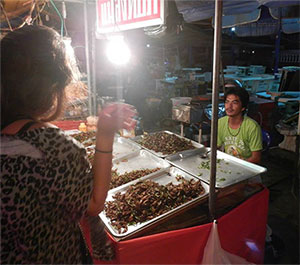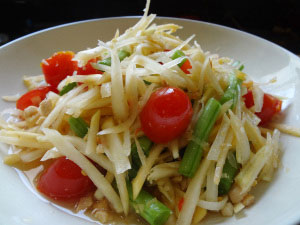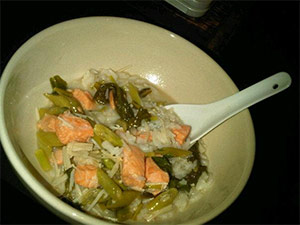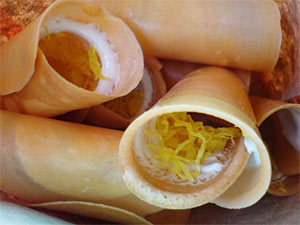Home > Gluten Free Travel Stories > Getting gluten free street food in Thailand
Getting gluten free street food in Thailand
TweetMarley Davidson is a Canadian teacher living in Thailand. Diagnosed coeliac fairly recently, she has worked out how to eat gluten free in Thailand, and has written this guide to getting gluten free street food when you're there.
If you've ever read an article or Lonely Planet introduction to Bangkok, then you'll know this sweaty city is renowned for its street food. Markets selling fresh produce and silk are abundant, as are Thais congregating street-side to share a meal.

Deep fried grasshoppers and cockroaches
Ferrang, the Thai word for foreigners, often ignore such street restaurants; but with the huge insurgence of money-minded backpackers, more and more travelers are eating with the locals. And of course the food is good - most meals are around 40 baht ($1.32CAD or £0.83GBP) for a bowl of pork spare rib soup with rice noodles or pad thai. Not only that, but street food is plentiful as most Thais prefer to snack or eat when they're hungry, which is a huge contrast to Western dining practices.
But what if you have Celiac disease? Then my friends, it gets tricky. Sure, it's great to save money on food so you can spend it on shopping. But is the expense to your gut really worth it?
After living here for a year, I think I have this tricky situation sorted. Some blogs recommend carrying a gluten-free card (which is great for restaurants) or totally avoiding street food full stop. For me though, that's simply not an option due to my haphazard traveling and equally haphazard budget.
The first thing I suggest you do is learn to recognize soy sauce. It's everywhere and it's evil. Learn to say "I don't want soy sauce" - my oww nahm see ew and practice that with a Thai person at your hotel or hostel.
I can hear you clamouring - but there is gluten free soy sauce out there! And yes, you're absolutely right! However, I can guarantee that no street vendor will have it as it A) costs 40 baht per bottle in comparison to the meagre 14 baht and B) Celiac disease in Asia is as rare as a chicken milking a cat. However, my theory is that this will change with all the Pizza Companys and McDonalds in the next ten years.
Next, become discernible when approaching street food. You have to first identify if there is only one wok for cooking. Most street vendors won't have adequate dish washing facilities. Read: they won't wash their wok between customers' meals. This can lead to gluten contamination and the choice is yours. Do you want to spend the next few days feeling like a smashed cockroach on the concrete? No? Walk away. Buy some fresh fruit or juice instead.
If you approach a stand and see that they only have "fish sauce" - practice your Thai: nam bplah ok - and have a clean wok, go for it! All of this applies to restaurants too!

Som Tam Salad
Now, one of my personal favourites is Som Tam. This is a young papaya salad, mixed with shrimp, tomatoes, carrots, chilies, green beans and peanuts. The sauce is made from sugar, lime, Thai garlic and fish sauce. You'll see people preparing this in wooden bowls, often mashing the sauce ingredients, then mixing in the others.
In addition, I would recommend the BBQ meats on little skewers and sticky rice. I've not been sick from those. Although, I would stay away from Chinese type pork and chicken, you know, the red glazed meats that hang from vendors' stalls. And although rice noodles are everywhere, be very wary of soups due to soy sauce in the broth and wontons as they're usually made with wheat and not rice. To be honest, I stay away from street soups and sauces. Just another word of caution: if noodles are any other colour besides white, again, I tend to avoid them.
On the plus side, most curries are safe as their flavour is derived from a unique mix of spices blended together. Then coconut milk or cream is added to thicken it, before adding the meat and veg. I would recommend ordering plain steamed rice (khao - like cow), rather than fried rice which will inevitably have soy sauce.

Thom Ka Soup
I also love Thom Kha soup, which is a sour soup made predominantly from coconut milk and flavoured with lemongrass. Served with mushrooms and meat (salmon in the picture), some restaurants will serve it with a spot of chili oil on the top. Deeelish!

Thai Pancakes
If you fancy something sweeter, go for the pancakes or Thai fortune cookies, as I know them. These are both made from rice flour and have a ridiculous amount of sugar. The fillings are usually sweet corn, grated coconut and coconut cream. Fillings can also be savoury but I haven't tried them. I like my pancakes sweet - hey, I'm Canadian after all! Street vendors also sell thicker pancakes, which is essentially the same recipe with the inclusion of eggs. These are great for breakfast or to include in your pack for a trip.
Most Thai desserts feature traditional ingredients: coconuts, bananas, sesame seeds, tapioca, rice flour, arrowroot flour, mango and beans. That's right, I said beans. Mung bean particularly, is used in many desserts because it is quite gloopy and used as a thickener. A common street food dessert is sticky rice topped with coconut cream and served in little squares or banana leaf. Speaking of sticky rice, of course you're familiar with mango and sticky rice. Well guess what? It's gluten free! As are bananas boiled in coconut milk and cantaloupe sago.
If you'd like to try a good range of Thai food without the risk of being glutened, I would firstly recommend a funky place called Cabbages & Condoms on Sukhumvit Soi 12 in Bangkok. Please don't be put off by the name as it is actually a wonderful restaurant that funds several charities in Thailand. Using the advice from this post will steer you in the right direction.
For more on surviving gluten free in Thailand, check out Marley's blog
And of course, remember your Thai gluten free language card
I hope that this celiac travel story has helped you. You can help other celiacs travel more safely by telling me about getting gluten free food in your area - remember where you live is a destination too! Send me a report and I'll let thousands of celiacs know.
Go back to Celiac Travel Stories



